Hunter 45CC
Comfort, sailability and style mark a new direction
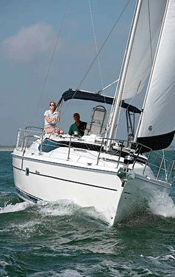 Be prepared for long lines snaking along the docks near the new Hunter 45CC at this year's round of boat shows. Trust me, be patient, this is one boat you are going to want to take a close look at. The crew at Hunter is excited about their latest center cockpit cruiser. And for good reason, this striking design continues Hunter's relentless effort to raise the bar on quality and innovation while maintaining a commitment to building boats people can actually afford. I suspect Hunter's competitors are not quite as excited.
Be prepared for long lines snaking along the docks near the new Hunter 45CC at this year's round of boat shows. Trust me, be patient, this is one boat you are going to want to take a close look at. The crew at Hunter is excited about their latest center cockpit cruiser. And for good reason, this striking design continues Hunter's relentless effort to raise the bar on quality and innovation while maintaining a commitment to building boats people can actually afford. I suspect Hunter's competitors are not quite as excited.
The 45CC replaces the popular 456 and early sales clearly indicate that this model is going to pick up where the 456 left off. Like all Hunters, the 45CC contains design inspiration by company founder Warren Luhrs. However, the boat has Glenn Henderson's fingerprints all over it. Henderson is Hunter's director of engineering and chief designer.
"To design a center cockpit is something of a challenge because of the location of the cockpit," he said. "We took a long time playing with floorboard height, the flow of the boat fore and aft and the center of gravity. If you look at the 45CC from the side it is hard to tell it's a center cockpit because it's so sleek and streamlined." Naturally Henderson is a tad biased but I must admit his comments are right on the mark.
In keeping with all his designs, Henderson worked hard to keep the overall profile low. The wraparound windshield and soft deck contours give the boat a contemporary look and yet there is something purposeful and practical about the design that I like. Like all big Hunters the boat is comfortable, yet the 45CC is designed and engineered for serious cruising and you can feel it the moment you climb aboard. We recently tested the boat in the Atlantic waters off St. Augustine, Florida. The conditions were on the light side, still the 45CC offered a surprising turn of speed and when it was time to return to the city marina the boat nimbly slipped down the inlet channel under main and cruising spinnaker.
The details
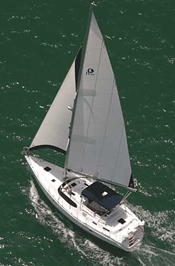 The hull is sensibly constructed with solid fiberglass laminate from the waterline south and balsa coring in the topsides. Forward sections also contain Kevlar reinforcements for strength and fracture resistance in the advent of a collision. The hull shape features a keel stub with external lead ballast externally fastened. This method of construction serves to lower the center of gravity and actually combines the best of both worlds when it comes to the internal vs. external ballast debate. The keel stub provides a sump area in the bilge, while the external ballast offers advantages in a hard grounding. Speaking of grounding, Hunter's director of offshore testing, round-the-world sailor Steve Pettingill, does just that with every new model. "I give the people on the beach a scare, when I repeatedly run the boat aground. But we really do test these boats, we want to see how everything holds together in a real world situation," Pettingill said.
The hull is sensibly constructed with solid fiberglass laminate from the waterline south and balsa coring in the topsides. Forward sections also contain Kevlar reinforcements for strength and fracture resistance in the advent of a collision. The hull shape features a keel stub with external lead ballast externally fastened. This method of construction serves to lower the center of gravity and actually combines the best of both worlds when it comes to the internal vs. external ballast debate. The keel stub provides a sump area in the bilge, while the external ballast offers advantages in a hard grounding. Speaking of grounding, Hunter's director of offshore testing, round-the-world sailor Steve Pettingill, does just that with every new model. "I give the people on the beach a scare, when I repeatedly run the boat aground. But we really do test these boats, we want to see how everything holds together in a real world situation," Pettingill said.
A structural grid that provides hull stiffness and internal support is bonded to the hull with Plexus, a powerful bonding agent developed for the aerospace industry that has been nicknamed "fiberglass fusion." This grid forms the basis for Hunter's completely modular construction and the process eliminates the need for secondary bonds. Once the grid is lowered into place, there is no moving it. Yes, the alignment is critical. Hunter's efficient construction techniques have been honed over the years and translate into savings for the consumer. The early days of modular construction were not always pretty, but Hunter's current boats are extremely well engineered. In addition, Hunter continues to upgrade the components used in construction and the 45CC includes fittings and materials from Lewmar, Corian, Edson, Harken, Selden, Yanmar and a host of other top manufacturers. Another standard feature sailors will appreciate is a 360-degree rubrail with a stainless guard for those times when the fenders are in the wrong spot when coming alongside.
On deck
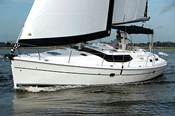 A well-designed cockpit is critical in a center cockpit boat simply because space is at a premium. Our test boat was fitted with a folding wheel that opened up space without the need for removing the wheel from the pedestal. The comfortable seats are covered with Flex-teek, Hunter's synthetic teak that looks great, provides decent traction and requires no maintenance. One advantage of a center cockpit is that it typically affords good visibility from the helm and this is definitely the case with the 45CC with its low-slung coachroof. There is a clever integral handrail on the huge pedestal, a large fold-out table and two coaming lockers.
A well-designed cockpit is critical in a center cockpit boat simply because space is at a premium. Our test boat was fitted with a folding wheel that opened up space without the need for removing the wheel from the pedestal. The comfortable seats are covered with Flex-teek, Hunter's synthetic teak that looks great, provides decent traction and requires no maintenance. One advantage of a center cockpit is that it typically affords good visibility from the helm and this is definitely the case with the 45CC with its low-slung coachroof. There is a clever integral handrail on the huge pedestal, a large fold-out table and two coaming lockers.
All sail controls are led aft and our test boat included an electric halyard winch to starboard. A stainless arch, a Hunter trademark, supports the Harken mainsheet traveler with leads and stoppers led down each side. This frees up additional cockpit space and is an important safety feature as the mainsheet and boom are out of harm's way. Hunter has worked hard to make its boats easy to handle and the 45CC is no exception. The robust arch also forms a natural, all weather support for the bimini top.
The double-spreader spar by Seldon features Hunter's B&R rig. Henderson is a firm believer in fractional rigs, declaring, "I'll never design another masthead rig." A large main powers the 45CC and the standard jib is a barely overlapping 110-percent genoa. Vertical battens allow the optional furling main to maintain a bit of roach and nice overall shape. Henderson also believes that a boat should be easily driven and not require mountains of canvas to attain hull speed. He describes a matrix that combines the sailplan, the keel and the balanced spade rudder working in harmony to create lift while keeping the CG as low as possible. The headsail includes Furlex roller furling gear standard. The jib tracks are well inboard setting up tight sheeting angles. A rigid vang is standard.
Hunter has done a superb job of fiberglass sculpting and the nonskid on deck provided firm footing as I made my way forward. A beefy stainless steel stemhead fitting with double offset anchor rollers, an external chain locker and an electric windlass are all standard. The stanchion bases are supported by threaded aluminum backing plates. The double lifelines include three opening gates. The stern rail seats are a great place to tarry while underway or at anchor. Two large transom lockers gobble up gear and our test boat was fitted with optional fender holders. The swim platform is a bit a narrow but a clever telescoping stainless ladder makes it easy to climb back aboard after a swim. And of course there's a hot shower for a quick rinse.
Down below
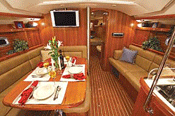 The spacious interior is bathed in natural light. Hunter's level of interior finish has steadily improved and the teak joinerwork in the 45CC is first class. The plan is fairly typical of most large center cockpit cruisers but the overall sense of spaciousness is unique. From the foot of the elegant, slightly curved companionway steps, the galley is to starboard. U-shaped with a handsome molding that doubles as a practical fiddle and handhold, the galley is located in the center of the boat-perfect for cooking underway.
The spacious interior is bathed in natural light. Hunter's level of interior finish has steadily improved and the teak joinerwork in the 45CC is first class. The plan is fairly typical of most large center cockpit cruisers but the overall sense of spaciousness is unique. From the foot of the elegant, slightly curved companionway steps, the galley is to starboard. U-shaped with a handsome molding that doubles as a practical fiddle and handhold, the galley is located in the center of the boat-perfect for cooking underway. 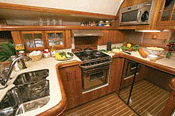 There is plenty of counter space, two sinks, and a side-by-side front-loading fridge and freezer. This arrangement may not be as efficient as a top loading system with six inches of foam and hatches you can barely lift, but it sure is convenient. The two-burner gimbaled stove faces outboard. I particularly like the glass cabinets behind the stove and the built-in coffeemaker next to the microwave.
There is plenty of counter space, two sinks, and a side-by-side front-loading fridge and freezer. This arrangement may not be as efficient as a top loading system with six inches of foam and hatches you can barely lift, but it sure is convenient. The two-burner gimbaled stove faces outboard. I particularly like the glass cabinets behind the stove and the built-in coffeemaker next to the microwave.
The nav station is opposite the galley, and the pivoting, sumptuous easy chair is the nav seat I have been dreaming of for 25 years. Designed for the new Raytheon E series multifunction displays, the nav station is set up for paper-free wayfaring. No thanks, I still like charts and I am happy to report that the nav desk is large enough to plot on and to store once folded charts inside. The saloon includes a large, furniture-quality table to port that accommodates six comfortably and a settee to starboard. Our test boat was fitted with all the bells and whistles including a flat screen television on the port main bulkhead. A great design feature is the single level floor. Many center cockpit designs have small steps between cabins that are annoying in port and dangerous at sea.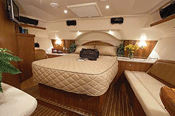 The forward stateroom features a V-berth without the need for a filler cushion, it's a real double berth complete with a seven-inch mattress and easy access storage below. There's a cedar-lined hanging locker and a dressing seat to starboard. There is also plenty of headroom and excellent ventilation. The en suite head includes a stall shower and Corian vanity. The interior is chocked full of small innovations and features that help define a new quality ethos for Hunter. From windshield shades, to overhead fluorescent lighting, to standard smoke and carbon monoxide detectors in every cabin, Hunter has not skimped in the fitting out of the 45CC.
The forward stateroom features a V-berth without the need for a filler cushion, it's a real double berth complete with a seven-inch mattress and easy access storage below. There's a cedar-lined hanging locker and a dressing seat to starboard. There is also plenty of headroom and excellent ventilation. The en suite head includes a stall shower and Corian vanity. The interior is chocked full of small innovations and features that help define a new quality ethos for Hunter. From windshield shades, to overhead fluorescent lighting, to standard smoke and carbon monoxide detectors in every cabin, Hunter has not skimped in the fitting out of the 45CC.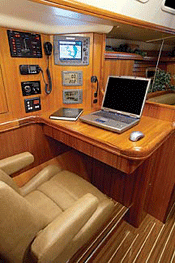 The master stateroom aft justifies any compromises of a center cockpit design. It is elegant, comfortable and refreshingly practical. Yes, the centerline queen berth with a real mattress will be difficult to sleep in underway, but it sure will be nice when the boat is tied up or swinging on the hook. And when you analyze how much time you spend underway versus at rest, even hard-core liveaboard cruisers generally are in port 10 nights for each night spent at sea. There are convenient bench seats on each side of the berth, two cedar-lined hanging lockers, and Corian covered nightstands with stainless fiddles. There is ample storage in drawers and lockers and terrific ventilation with seven opening ports and a large overhead hatch. The private aft head includes a clever bi-fold door for the shower.
The master stateroom aft justifies any compromises of a center cockpit design. It is elegant, comfortable and refreshingly practical. Yes, the centerline queen berth with a real mattress will be difficult to sleep in underway, but it sure will be nice when the boat is tied up or swinging on the hook. And when you analyze how much time you spend underway versus at rest, even hard-core liveaboard cruisers generally are in port 10 nights for each night spent at sea. There are convenient bench seats on each side of the berth, two cedar-lined hanging lockers, and Corian covered nightstands with stainless fiddles. There is ample storage in drawers and lockers and terrific ventilation with seven opening ports and a large overhead hatch. The private aft head includes a clever bi-fold door for the shower. 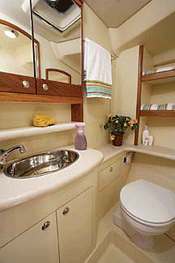 The 45CC comes standard with a 75-horsepower Yanmar diesel and a three-blade prop. Access to the engine is excellent, especially from a side panel in the aft walk through. The vanity tilts out of the way in the aft cabin to allow unobstructed access to the stuffing box. Seventy-five gallons of fuel translates into more than 500 miles of range for this fuel-efficient engine and easily driven hull shape. All tanks have gauges and overall the mechanical systems are first rate. Through-hull fittings below the waterline are bronze and most pumps, compressors and other components are easily accessible. Indeed, this was a major design factor.
The 45CC comes standard with a 75-horsepower Yanmar diesel and a three-blade prop. Access to the engine is excellent, especially from a side panel in the aft walk through. The vanity tilts out of the way in the aft cabin to allow unobstructed access to the stuffing box. Seventy-five gallons of fuel translates into more than 500 miles of range for this fuel-efficient engine and easily driven hull shape. All tanks have gauges and overall the mechanical systems are first rate. Through-hull fittings below the waterline are bronze and most pumps, compressors and other components are easily accessible. Indeed, this was a major design factor.
Under sail
Out on the Atlantic, we put the 45CC through a rigorous test under power, spinning the boat in its own length several times. There is a bit of wash from the large prop but that's a fair trade for 7 knots of speed. Satisfied with the boat's performance under power, we canned the engine and unfurled the sails. The wind fluttered around 10 knots. We sailed south, on a close reach, touching 6 knots. The ride was smooth despite a light chop and the helm was balanced. Indeed, I let the wheel go for minutes at a stretch. Pinching up, we sailed inside 40 degrees apparent with ease and only started pinching when we neared 30 degrees apparent. Tacking was easy with the small headsail and trimming the main is done primarily with the traveler. The 45CC accelerated pretty well for a serious cruiser and I confess, I was surprised by the soft ride.
Cracking off onto a reach we set the asymmetrical chute. One disadvantage of the sweptback B&R rig is that you can't pay the main out very far, which makes deep reaching tough. However, the sails set nicely at about 120 degrees off and we skipped along at nearly 6 knots. Hauling in the sheet, we easily carried the chute while reaching up at 70 degrees. Heading back toward the inlet we tacked downwind, which is something of a misnomer as you actually jibe. We made a series of jibes with the spinnaker. This is also when you appreciate having the traveler overhead, jibes are not as dangerous, and we made short work of the distance back to the marina. Waiting for the old bascule bridge to open we tested the ground tackle. The anchor was a snap to deploy and I was impressed as the Simpson Lawrence windlass easily transitioned between the rope chain splice.
The new Hunter 45CC is a welcome addition to the cruising boat market. It won't be long before you begin to see this handsome sloop anchored in the watery crossroads of the world.

Comments